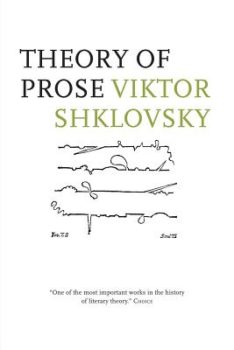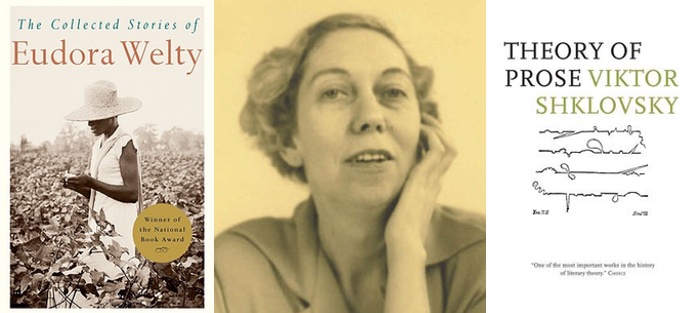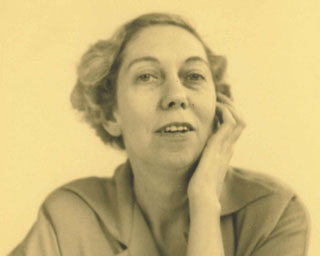Editor’s Note: For the first several months of 2022, we’ll be celebrating some of our favorite work from the last fourteen years in a series of “From the Archives” posts.
In today’s feature, part two of a three-part essay, Christina Ward-Niven explores unconventional point of view in Eudora Welty’s “The Bride of Innisfallen.” This essay was originally published on December 6, 2016.
Unconventional Point of View and Characterization
in Welty’s “The Bride of the Innisfallen”
(also defamiliarization versus “enstrangement”)
Writing decades later on the other side of the world, Eudora Welty was a Chekhov devotee. In her 1977 essay, “Reality in Chekhov’s Stories,” she writes: “Chekhov’s perception of our differing views of reality, with its capacity to understand them all, may have done more than anything else to bring about his revolutionizing of the short story.” She goes on to note his talent for reflecting “the stuff of life” in his stories, including the “transient, ephemeral, contradictory” aspects of reality—the mysterious and strange elements of our daily lives. “Indeed,” she writes, “Chekhov leads us to discover that what we should have thought the most incongruous detail is in fact the most probable.”
 I’m struck by that idea: the most incongruous becoming the most probable. It seems to me another way to describe defamiliarization. We want unlikely elements in our stories, but we want them, in the end, to seem exactly right. Returning to “On Defamiliarization,” Charles Baxter says this process involves noticing misfit details: “details that don’t belong, that don’t fit,” but are nonetheless part of life. One of his examples: “On the way to divorce court, we stop at the Dairy Queen.” Baxter writes that when you encounter such a moment in a story, “the familiar gives way, not to the weird, but to the experience of a truth caught in mid-air.”
I’m struck by that idea: the most incongruous becoming the most probable. It seems to me another way to describe defamiliarization. We want unlikely elements in our stories, but we want them, in the end, to seem exactly right. Returning to “On Defamiliarization,” Charles Baxter says this process involves noticing misfit details: “details that don’t belong, that don’t fit,” but are nonetheless part of life. One of his examples: “On the way to divorce court, we stop at the Dairy Queen.” Baxter writes that when you encounter such a moment in a story, “the familiar gives way, not to the weird, but to the experience of a truth caught in mid-air.”
Russian writer Viktor Shklovsky’s “Art as Technique” served as a starting point for Baxter’s essay, and it was Shklovsky who originally coined the term “defamiliarization,” which is a translation of the Russian word ostraniene. I tracked down a copy of Shklovsky’s 1917 essay, though a different translation—titled “Art as Device,” translated by Benjamin Sher and published in 1990, about 25 years after the edition to which Baxter refers. In an introductory note, Sher strongly disagrees with previous translators’ use of the word “defamiliarization,” which he first calls “quite wrongheaded,” and then later, “dead wrong”:
Shklovsky’s process is in fact the reverse of that implied by this term [defamiliarization]. It is not a transition from the “familiar” to the “unknown” (implicitly). On the contrary, it proceeds from the cognitively known … to the familiarly known, that is, to real knowledge that expands and “complicates” our perceptual process …
The unexpected can actually move the reader from one kind of knowledge to another: from an automated kind of knowledge to a more complex kind of knowledge. To go back to Baxter’s example, let’s say the expectation for a couple headed to divorce proceedings might be two people, in separate cars, arriving at the courthouse and walking in with little more than cursory nods to each other. If we come upon that scene in a story or novel, we probably don’t slow down much to consider it. But change the scene to the unexpected image of a couple, en route to terminate their marriage, driving together, deciding to stop at a Dairy Queen. Encountering this, we pause—we remember that they are still two human beings who once cared deeply for each other (and still might), who still get hungry, who still like ice cream. The incongruous becomes probable. Instead of simply going from “familiar to unfamiliar,” we’ve moved from one kind of understanding (easy, autopilot) to another kind (more challenging and thought-requiring, but just as “familiar,” once we recognize it).
I’ll continue to use “defamiliarization” in this essay, but I should add that Sher, in translating ostraniene, created instead the word “enstrangement”—that’s not a typo, the “n” comes after the initial “e”—which he explains combines the idea of “making something strange” with the separation implied by the word “estrangement.” Why does he see a need for implied separation here? By changing the familiar-ordinary into something familiar on a more surprising level, you are lifting it out of its original meaning—so it can be better noticed and understood.
Translation issues aside, Shklovsky’s essay discusses the issue of perception—how seeing or doing something habitually leads to “automization.” The object or action fades away and becomes nearly unnoticeable, and our responses to it go numb. Through art, we have the power to “return sensation to our limbs,” writes Shklovsky: “By enstranging objects and complicating form, the device of art makes perception long and ‘laborious.’” In other words, we want to the reader to have to work a bit harder—laborious is a good thing, here!—to perceive certain images that might otherwise go unnoticed.
Eudora Welty is a master of this. She deftly complicates form and description to make perception more challenging, and ultimately more rewarding, for the reader. She wants us to pay attention, just as her characters pay attention to their own everyday worlds. Welty’s “The Bride of the Innisfallen” is a travel story, with a protagonist whose senses seem heightened and alert as she navigates new surroundings. Like “The Student,” it’s also another deceptively ordinary narrative that, when summarized, might seem unremarkable: a young American woman travels from London to Cork by train and boat, encountering a variety of strangers along the way. The reader discovers early on that she seems to be leaving her husband, which adds some tension and interest, but it’s not this plot point that makes Welty’s story so compelling. Instead it’s the author’s unique way of telling the story, start to finish, that gives the work its odd power.
From the opening, “The Bride of the Innisfallen” employs an unconventional, shifting point of view to tell us about the characters in the story. By the end of the story, we come to see the unnamed “American girl” as the protagonist, but in the beginning we can’t be sure if any one character is at the center. Welty does not use the consistent close third- or first-person point of view we might expect from a story centering on the consciousness of one character. Rather, an omniscient voice narrates most of the story, zooming in to the interiority of various characters.
As the narrator of “The Bride of the Innisfallen” introduces passengers on the train, we often get both physical description as well as personality details that a fellow stranger in the train compartment would not yet be able to detect. For example, we discover one man’s procrastinating tendencies: “[The new passenger] had a neat, short, tender, slightly alarmed profile—dark, straight hair cut not ten minutes ago, a slight cut over the ear. But this still-bleeding customer, a Connemara man as he was now announcing himself, always did everything last-minute, because that was the way he was made.” Similarly, amid description of another newly arrived passenger, we are told why he is checking his pockets: “A big tall man climbed on … the tall Welshman drove into the compartment … In the silence of the dreary stop, he slapped all his pockets—not having forgotten anything, only making sure.”
One of the most notable instances of omniscient “zooming in” comes when a young Irish passenger steps out of the train compartment for a moment, leaving her boyfriend inside, and we are given access to her consciousness for the first time in the story. This is particularly striking because the American girl is still inside the compartment, as are the other characters; here again it is truly an omniscient narrator who is “seeing” what this girl is doing and thinking:
[The young sweetheart] left the compartment. All alone she stood in the corridor. … She hung her head out the open corridor window into the Welsh night, which, seen from inside itself—her head in its mouth—could look not black but pale. Wales was formidable, barrier-like. What contours which she could not see were raised out there, dense and heraldic? Once there was a gleam from their lights on the walls of a tunnel, from the everlasting springs that the tunnelers had cut. Should they ever have started, those tunnelers? Sometimes there were sparks. She hung out into the wounded night a minute: let him wish her back.
Why this extended moment that tells us what a minor character is thinking? After this paragraph, we never again have access to the young Irish lover’s thoughts. But Welty is telling us something about the American girl when she details the consciousness of other characters. For example: “What contours which she could not see were raised out there…?” echoes the questions of this entire journey itself for the American, who, we will discover by the end of the story, is embarking on a new, unpredictable chapter of her life. “Should they ever have started…?” sounds less like a concern for “these tunnelers,” and more like a reflection on a failing relationship—such as a marriage in trouble. “Let him wish her back” is lighthearted in reference to the young lovers, but it also brings to mind the more serious act of the American abandoning her husband. These subtextual references to one character, when describing another, support Shklovsky’s idea—that by making perception more challenging, less straightforward, the reader will ultimately find more to recognize.
 Amid the flashing glimpses into various characters’ thoughts and actions, we find hints along the way that, eventually, this story will limit itself to the American’s point of view. But they are only hints. Welty doesn’t extensively focus the narrative on the American until the end of the journey, after the passengers transfer from the train to the boat (the Innisfallen) and arrive in Cork. The point of view then goes into close third-person, and we have access to the American’s thoughts for the final two pages of the story. Still, we never learn her name, her age, details about her past in the United States, or the exact nature of her marital problems.
Amid the flashing glimpses into various characters’ thoughts and actions, we find hints along the way that, eventually, this story will limit itself to the American’s point of view. But they are only hints. Welty doesn’t extensively focus the narrative on the American until the end of the journey, after the passengers transfer from the train to the boat (the Innisfallen) and arrive in Cork. The point of view then goes into close third-person, and we have access to the American’s thoughts for the final two pages of the story. Still, we never learn her name, her age, details about her past in the United States, or the exact nature of her marital problems.
Looking back at the beginning, my sense is that despite the clear omniscience, we are somehow still getting this story from the American girl’s point of view. There is no single overt protagonist until the end but rather a kind of traveling collective-group protagonist. Even so, Welty very subtly implies that we’re seeing everything through the American’s eyes. Why does it even matter whose viewpoint we get, or who is at the center of this story, or any story? It doesn’t, except in how it connects to the meaning—to the spirit, or soul, of a story. “The Bride of the Innisfallen” is about a woman’s search for independence despite the risks and losses involved, and the way this theme reveals itself through subtext becomes an underlying support structure that grows as the character’s journey progresses. The descriptions of the other passengers, and their overheard conversations, ultimately provide insight into the American girl’s state of mind, which is revealed more fully once she arrives in Cork.
So, omniscience notwithstanding, I’d argue that it is a story from the American’s point of view from the beginning. It’s almost—almost—as though she is omniscient. For me, this is an example of the “incongruous yet probable.” It’s not such an unusual method of characterization, telling the reader about one character by describing others. The way we view others says something about us. But Welty’s method is especially mysterious, because we aren’t completely sure we are seeing the strangers through the American’s eyes, but we increasingly intuit that we are. It’s an unconventional, unfamiliar-yet-familiar way of fleshing out a character. Though it’s common in fiction for landscape, or even other characters, to reflect a protagonist’s interior state, what’s strange here is how limited the details are about the protagonist—so limited it’s hard to call her the protagonist!—so we have almost nothing but the description of others to piece together what the American girl is thinking. (And what she is thinking is, importantly, what the entire story is about.) We learn only scant details about her in the first 22 pages of the story, before the shift to close third. The longest stretch of information occurs about one page into the story:
The American girl sitting opposite could not have taken in anything they said as long as she kept feeling it necessary, herself, to subside. As long as the train stood in the station, her whole predicament seemed betrayed by her earliness. She was leaving London without her husband’s knowledge. She was wearing rather worn American clothes and thin shoes, and, sitting up very straight, kept pulling her coat collar about her ears and throat.
That’s all we know, at first, about her. We gradually learn through brief exchanges of dialogue with fellow passengers that she needs a place to stay in Cork, she has “a letter to write,” and her husband is a photographer. Then, a full 20 pages in, when the characters have transferred from the train to the boat and the story is nearly over, we arrive at this revealing moment:
Most third-class train passengers spent the night third-class in the Innisfallen lounge. The man from Connemara was the first one stretched, a starfish of exhaustion, on a cretonne-covered couch. … Once [he] sat up out of his sleep and stared at the American girl pinned to her chair across the room, as if he saw somebody desperate who had left her husband once, endangered herself among strangers, been turned back, and was there for the second go-around, asking again for a place to stay in Cork. She stared back motionless, until he was a starfish again.
What an original way to give us this glimpse into her troubled marriage—through nothing more than the expression on another character’s half-asleep face.
There is a thematic focus throughout “The Bride of the Innisfallen” on couples and marriages, and the language used to describe them is often slightly burdened. The couple saying good-bye at the start of the story (a man is seeing a woman off, on the train) seem upset to be parting, but there is something oppressive in their actions, too: “When the round man put the suitcase up in the rack, [the woman] sank down under it as if something were now done that could not be undone, and with tender glances brushed the soot and raindrops off herself, somewhat onto him.” The phrasing here (“sank down under,” “something now done that could not be undone,” and “brushed the soot …onto him”) does not exactly ring with the giddy language of love. This same woman wears on her hat “a gold pin in the shape of a pair of links, like those you are supposed to separate in amateur-magician sets.” It’s significant that a small detail of jewelry is described in terms of how it could be potentially pulled apart. Is it an omniscient narrator, or actually the American girl escaping her husband, who is thinking about “something now done that could not be undone?” Is she the one thinking about the tricky process of separating a pair?
Meanwhile, the pair of young lovers enters the compartment “like a shadow,” and they are “just not twining, touching, just not angry, just not too late.” Later, “the young man’s arm was thrust along the seat and she was sitting under its arch as if it were the entrance to a cave.” Again, the word choice implies something less than blissful. A cave is absent of light; here and elsewhere, there’s a distinctly dark edge.
Among other not-so-glowing relationship references throughout the story, the man from Connemara tells the group that he suspects his wife may have killed his beloved bird. He also recounts a tale of a pair of married ghosts in an Irish castle who destroyed each other. And though the bride of the story’s title is stared at “in delight” by everyone around when she appears at the rail of the Innisfallen, she is notably alone, and there’s a sense of isolation in the image: she “smiled but did not look up; she was looking down at her dazzling little fur muff.” I can’t help but think Welty is saying something here about the boxing-up of women in marriage, the trappings of weddings. (It’s important also to remember the era and women’s expected roles in society; this story was first published in 1955.) The bride of the Innisfallen is on display, and she is smiling not at her groom or family, but at her fancy muff. Later, at the end of the story, the American thinks back to the bride on the boat as though she had been on the verge of some kind of invisibility: “When early this morning the bride smiled, it might almost have been for her photograph; but she still did not look up—as though if even her picture were taken, she would vanish. And now she had vanished.” Again, a subtle message about our protagonist: she is wary of marriage, wary of a woman’s loss of independence and disappearance in marriage.
Welty’s unique characterization here works on us through subtext; it destabilizes through subtext. We may not even realize the impact of the descriptions of the strangers as we read, but in the end—when the point of view shifts into close third and we see how much the young American woman truly desires to be on her own—the accumulated characterizations have had a thematic effect.
Welty’s shaping of this story is unusual, certainly—why not use close third- or first-person from the start, to give us an immersive, fuller sense of this one character? Why provide so little direct information about the American girl? We never even learn her name. The ending of the story serves as a possible explanation. In the final lines, the American, wandering happily through the streets of Cork, steps out of the rain to take shelter in the doorway of a pub. She has been trying to write a message to send to her husband, to explain her departure, and she finally gives up. The story concludes: “The girl let her message go into the stream of the street, and opening the door walked without protection into the lovely room full of strangers.” The phrase “walked without protection” is key. This character is stepping away, quite bravely and unconventionally, from the security of her marriage, much as the student in Chekhov’s story chose to step away from the familiar path on his walk home, a choice that led to a moment of illumination. (Just as the authors of these stories stepped away from familiarity in their storytelling choices, leading to moments of illumination for the reader.) “The Bride of the Innisfallen” is a story about finding oneself, or perhaps rediscovering oneself. In the end, this young woman realizes she can find herself through, and among, unfamiliar people—such as the strangers surrounding her since the beginning of the journey, when she boarded the train in London. Meanwhile, the reader has been discovering who the American is through those same strangers, all along. As we come to the close of the story, Welty’s point-of-view and characterization choices come to seem strangely, yet exactly, right.







